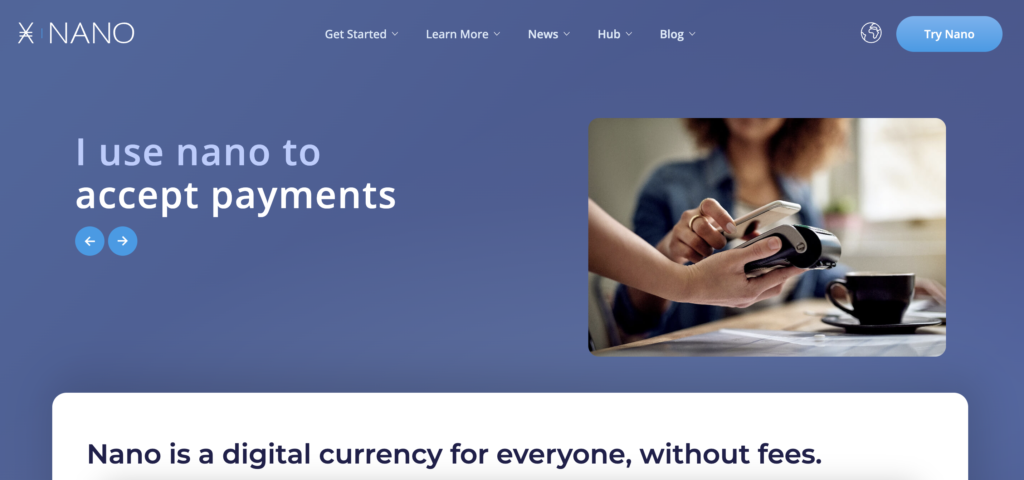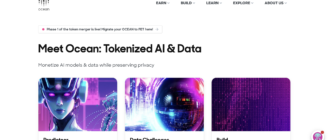In this article, we will delve into the intricacies of the Nano project and its cryptocurrency, XNO. Nano stands out in the crowded cryptocurrency landscape with its unique approach to digital payments, leveraging a Directed Acyclic Graph (DAG) data structure and the innovative block-lattice architecture. This article will explore the Nano project’s history, technological framework, tokenomics, ecosystem, growth prospects, and future outlook, providing a comprehensive understanding of this pioneering cryptocurrency.

What is Nano?
Nano is a revolutionary digital payment protocol designed to facilitate instant, fee-less transactions. Unlike traditional cryptocurrencies that rely on blockchain technology, Nano utilizes a unique block-lattice structure within a Directed Acyclic Graph (DAG) data architecture. Each account on the Nano network has its own blockchain, called an account-chain, which can be updated asynchronously. This design allows for highly efficient transaction processing and eliminates the need for miners, thereby significantly reducing energy consumption. Nano aims to provide a scalable and sustainable solution for everyday transactions, making it an attractive option for both personal and business use.
History of the Nano Project
The Nano project was founded in 2015 with the goal of creating a fast, fee-less, and eco-friendly cryptocurrency. Initially launched under the name RaiBlocks, the project quickly gained attention for its innovative block-lattice architecture. In early 2018, RaiBlocks rebranded to Nano to better reflect its vision of simple and efficient digital payments.
Key milestones in the development of Nano include:
- 2015: Launch of RaiBlocks, introducing the novel block-lattice structure.
- 2017: Significant growth in user adoption and transaction volume, driven by the cryptocurrency boom.
- 2018: Rebranding from RaiBlocks to Nano, alongside the introduction of Universal Blocks, which unified four different block types into a single, more efficient block type.
- 2020: Continued development and optimization of the network, including improvements to the consensus mechanism and node performance.
- 2021: Enhancements to the Nano protocol to further improve transaction speed and network resiliency, particularly during periods of heavy use.
Throughout its history, Nano has remained focused on its core principles of providing a feeless, instant, and environmentally sustainable digital currency, continually evolving to meet the needs of its growing user base.
How Nano Works
Nano operates on a unique technological framework that sets it apart from traditional blockchain-based cryptocurrencies. At its core, Nano employs a block-lattice structure, a type of Directed Acyclic Graph (DAG) architecture, which enables each user to have their own blockchain, known as an account-chain. This structure allows transactions to be processed independently and asynchronously, greatly enhancing the network’s efficiency and scalability.
Block-Lattice Architecture
The block-lattice architecture is a fundamental innovation of the Nano network. Unlike conventional blockchains where all transactions are recorded on a single, shared ledger, Nano’s block-lattice allows each account to maintain its own blockchain. Each account-chain can only be modified by its owner, which means that transactions are directly updated on the respective account-chains without the need for global consensus.
In practical terms, when a user initiates a transaction, they create a “send block” on their account-chain, and the recipient must create a “receive block” on their own account-chain to complete the transaction. This dual transaction system ensures that transactions are confirmed almost instantly, with minimal computational overhead.
Consensus Mechanism: Open Representative Voting (ORV)
Nano utilizes a consensus mechanism known as Open Representative Voting (ORV). This system replaces the traditional Proof of Work (PoW) and Proof of Stake (PoS) models with a more efficient and decentralized method. In ORV, account holders can delegate their voting power to a representative node. These representatives are responsible for validating transactions and maintaining the network’s integrity.
Representatives are elected based on the Nano balance of the users who delegate to them, but this delegation does not restrict the user’s ability to spend their funds. The representatives vote on the validity of transactions, and once a quorum is reached, the transaction is confirmed. This mechanism ensures a high degree of security and decentralization, as representatives are incentivized to act in the best interest of the network to maintain trust and avoid potential attacks.
Technical Details and Differentiation
Nano’s technical architecture is designed to address the common issues of latency, scalability, and energy consumption that plague other blockchain networks. Here are some key technical aspects:
- Instant Transactions: Due to the block-lattice structure, transactions on the Nano network are processed almost instantaneously. Each transaction is recorded in a single UDP packet, which minimizes processing delays and ensures rapid confirmation times.
- Energy Efficiency: Nano’s consensus mechanism does not require energy-intensive mining operations. The use of ORV and the block-lattice architecture significantly reduces the network’s carbon footprint compared to PoW-based cryptocurrencies like Bitcoin.
- Scalability: Nano’s independent account-chains allow for high throughput and scalability. Since each account-chain operates asynchronously, the network can handle a large volume of transactions without the bottlenecks associated with traditional blockchains.
- Security: The ORV consensus mechanism provides robust security against common attack vectors such as Sybil attacks and Denial-of-Service (DoS) attacks. The decentralized nature of representative voting ensures that no single entity can easily gain control of the network.
By leveraging these technologies, Nano offers a highly efficient, scalable, and environmentally friendly digital currency solution that addresses many of the limitations faced by traditional blockchain systems.
Tokenomics of Nano
Token or Coin?
Nano is best classified as a coin rather than a token. This distinction arises because Nano operates on its own proprietary blockchain, known as the block-lattice. In contrast, tokens typically exist on top of another blockchain, such as Ethereum or BNB Smart Chain. As a native cryptocurrency of its independent network, Nano functions as a coin.
Emission Model
Nano follows a fixed supply model, with a total of 133,248,297 NANO coins in circulation. Unlike many other cryptocurrencies that utilize inflationary models or continuous mining to increase supply, Nano’s entire supply was distributed during the initial distribution phase. This approach ensures that there is no new creation of coins, making Nano a deflationary asset over time as demand increases relative to the fixed supply.
Distribution and Initial Distribution Event
The entire supply of Nano was distributed through a unique mechanism known as the CAPTCHA faucet distribution. This method allowed users to solve CAPTCHA puzzles to earn Nano, ensuring a fair and broad initial distribution. The faucet distribution model was an innovative approach to prevent the concentration of coins in the hands of early miners or investors, promoting a more decentralized and accessible network from the start.
Market Performance
Nano has experienced significant fluctuations in its market value since its inception. After rebranding from RaiBlocks to Nano in early 2018, the coin saw a rapid increase in price, reaching an all-time high of approximately $35.00 during the cryptocurrency boom of late 2017 and early 2018. However, like many cryptocurrencies, Nano’s price has seen considerable volatility and has not maintained those peak levels.
Current Market Data (Example Table)
| Metric | Value |
|---|---|
| Total Supply | 133,248,297 NANO |
| Circulating Supply | 133,248,297 NANO |
| All-Time High (ATH) | $35.00 |
| Current Price | $0.95 (approx.) |
| Market Capitalization | $126,585,882 |
| Trading Volume (24h) | $5,000,000 |
Economic Model and Use Cases
Nano’s economic model is designed to support its primary use case as a digital payment solution. The fixed supply and feeless transaction model make Nano an attractive option for microtransactions, remittances, and everyday payments. By eliminating transaction fees, Nano enables users to transfer value without incurring additional costs, which is particularly beneficial for small transactions and cross-border payments.
Incentive Structure
Unlike many blockchain projects, Nano does not incentivize node operators with block rewards or transaction fees. Instead, the network relies on the intrinsic motivation of node operators, who often run nodes to support the network, enhance their reputation, or benefit indirectly through increased adoption and usage of the coin. This unique incentive structure contributes to Nano’s feeless transaction model, distinguishing it from other cryptocurrencies that require fees to sustain their networks.
Where to Buy Nano (XNO)
Nano (XNO) can be purchased on several prominent cryptocurrency exchanges, which provide various trading pairs and liquidity options. Here are the main exchanges where you can buy Nano:
- Binance: One of the largest and most popular cryptocurrency exchanges globally, Binance offers Nano trading pairs such as NANO/BTC, NANO/USDT, and others. Binance is known for its robust trading platform and extensive selection of cryptocurrencies.
- HTX (formerly Huobi): HTX provides a secure platform for trading Nano with pairs including NANO/BTC and NANO/USDT. HTX is known for its strong security measures and user-friendly interface.
- Gate.io: This exchange offers several trading pairs for Nano, providing good liquidity and a variety of trading options. Gate.io is popular for its wide range of listed tokens and user-centric features.
- BingX: Known for its advanced trading features and high liquidity, BingX supports trading pairs like NANO/USDT. It is a go-to platform for both spot and derivatives trading.
- KuCoin: Often referred to as “The People’s Exchange,” KuCoin offers Nano trading pairs such as NANO/BTC and NANO/USDT. KuCoin is appreciated for its user-friendly interface and extensive range of cryptocurrencies.
Where to Store Nano (XNO)
Storing Nano securely is crucial to ensuring the safety of your funds. There are several wallet options available that cater to different preferences, from mobile wallets to hardware wallets. Here are the recommended wallets for storing Nano:
Desktop and Mobile Wallets
- Nano Wallet (Nanowallet.io): This is the official desktop wallet for Nano, providing a secure and user-friendly interface for managing your Nano holdings. It supports features like account management, transaction history, and representative voting.
- WeNano: Available for both iOS and Android, WeNano is a social wallet that not only allows for the secure storage of Nano but also enables users to interact with other Nano users nearby, send tips, and discover new places accepting Nano.
- Natrium: A highly recommended mobile wallet available on both iOS and Android. Natrium offers a seamless and intuitive experience for sending, receiving, and managing Nano, with robust security features.
Hardware Wallets
- Ledger Nano S/X: For those seeking the highest level of security, the Ledger Nano S and Nano X hardware wallets are excellent choices. These hardware wallets support Nano and provide offline storage, which is crucial for protecting your funds from online threats.
Browser Extensions
- Nault: A web-based wallet that allows users to manage their Nano directly from their browser. Nault offers a lightweight and convenient solution for accessing your Nano funds, suitable for everyday transactions.
Each of these wallets provides various features to enhance the security and usability of your Nano funds. Depending on your preference for accessibility and security, you can choose the wallet that best meets your needs.
Project Growth Prospects
Nano’s growth prospects are rooted in its unique technology and strategic partnerships. The project’s emphasis on fee-less, instant transactions positions it well for mass adoption, particularly for microtransactions and cross-border payments. Nano’s primary clientele includes individuals seeking efficient digital payments, merchants aiming to reduce transaction fees, and businesses needing scalable payment solutions.
Key Clients and Partners
- MoonPay: Integration with MoonPay allows users to buy Nano directly via credit or debit cards.
- WeNano: A social wallet facilitating Nano transactions and enabling users to earn Nano by engaging in local activities.
- AnchorX: A platform that bridges the gap between Nano and popular online retailers, expanding its usability for online shopping.
Future Outlook
Nano is well-positioned to grow as it continues to enhance its network’s scalability and resilience. The introduction of features like Universal Blocks has already improved efficiency and network performance. The project’s commitment to sustainability, combined with its innovative technology, suggests a promising future as a leading digital payment solution.
Ecosystem
Nano’s ecosystem is diverse, encompassing a wide range of applications and services that utilize its technology. This ecosystem includes:
- Merchants: Various online and physical stores accepting Nano for payments.
- Wallets: Secure storage solutions like Nano Wallet, WeNano, Natrium, and hardware wallets such as Ledger Nano S/X.
- Developer Tools: Resources and documentation to help developers build and integrate with the Nano network.
- Gaming: Platforms that allow users to earn and spend Nano within games.
- Charities: Organizations that accept Nano donations, leveraging its fee-less transaction capability to maximize impact.
This ecosystem not only supports Nano’s adoption but also fosters a community of users and developers dedicated to enhancing the cryptocurrency’s functionality and reach.
Conclusion
Nano represents a significant advancement in the realm of digital currencies, offering fee-less, instant transactions with a focus on sustainability and efficiency. By employing a block-lattice structure and the Open Representative Voting (ORV) consensus mechanism, Nano aims to address many of the scalability and latency issues that plague traditional blockchain networks. As the ecosystem continues to grow and evolve, the potential for Nano to become a widely adopted digital payment solution remains a key point of interest for both enthusiasts and investors alike.






